CO2 Storage and Geothermal Extraction Technology for Deep Coal Mine
Abstract
:1. Introduction
2. General Scheme
3. Feasibility of CS-GEU Technology
3.1. CS in Mine Goaf
3.2. Mine GEU
3.3. CS-GEU Synergistic System in the Goaf
4. Scientific Issue of CS-GEU Technology in Deep Mine Goaf
4.1. CO2 Migration-Storage Evolution in the Mine Goaf
4.2. Multi-Field Coupling and Evolution Law of Mine Goaf
5. Techniques for Geothermal Extraction and CO2 Storage
5.1. CO2 Capture and High-Concentration CO2 Transport in Power Plants
5.2. Boreholes, HP Pipelines and Pipeline Supports in the Goaf
5.3. Sealing and Pressurizing Technology in the Goaf
5.4. Underground CO2 Leakage and CO2 Migration Monitoring Technology in the Goaf
5.5. High-Efficiency Variable-Condition Heat Pump and Gas-Liquid Separation Technology
6. Discussions
6.1. Limitations
6.2. Further Studies
7. Conclusions
Author Contributions
Funding
Institutional Review Board Statement
Informed Consent Statement
Data Availability Statement
Conflicts of Interest
Abbreviations
| Term | Abbreviation |
| Highly mineralized | HM |
| High temperature | HT |
| High pressure | HP |
| Water-rock-CO2 effect | WRCE |
| Geothermal extraction and utilization | GEU |
| Rock strata | RS |
| CO2 storage | CS |
| Underground coal gasification | UCG |
| Carbon capture and storage | CCS |
References
- Xie, H.P.; Ren, S.H.; Xie, Y.C.; Jiao, X.M. Development opportunities for coal industry under carbon neutrality target. J. China Coal Soc. 2021, 46, 2197–2211. [Google Scholar]
- Jin, Y.N.; Zheng, N.; Tian, Z.; Li, T.Y. Challenges and opportunities for the oil and gas industry from the Carbon Neutral Vision. Techno-Econ. Petrochem. 2021, 37, 1–6. [Google Scholar]
- Zhang, Y.S.; Chao, Q.C.; Chen, Y.; Zhang, J.Y.; Wang, M.; Zhang, Y.; Yu, X. China is carbon neutral: Leading global climate governance and green transformation. Int. Econ. Rev. 2021, 9, 2150019. [Google Scholar]
- Yang, Y.; Yu, H.Y.; Lu, G.; Wang, L.M.; Zhao, Y.; Hao, L.S.; Ren, D.M.; Fang, W.; An, H.Z.; Cai, T.G. Interview on the unprecedented changes of energy geopolitics and national energy security. J. Nat. Resour. 2020, 35, 2803–2820. [Google Scholar] [CrossRef]
- Chen, F.; Wang, S.Y.; Yu, H.C.; Chen, R.; Yang, Y.J.; Lu, J.S. The technological path of coal revolution under carbon neutral target. J. China Coal Soc. 2022, 47, 1452–1461. [Google Scholar]
- He, X.Q.; Tian, X.H.; Song, D.Z. Research progress and prospect of CO2 safe storage in coal seam. Coal Sci. Technol. 2022, 50, 212–219. [Google Scholar]
- Aminu, M.D.; Nabavi, S.A.; Rochelle, C.A.; Manovic, V. A review of developments in carbon dioxide storage. Appl. Energy 2017, 208, 1389–1419. [Google Scholar] [CrossRef]
- Liu, Y.H.; Ge, Q.S.; He, F.N.; Cheng, B.B. Countermeasures against international pressure of reducing CO2 emissions and analysis on China’s potential of CO2 emission reduction. Acta Geogr. Sin. 2008, 63, 675–682. [Google Scholar]
- Cao, C.; Hou, Z.M.; Xiong, Y.; Luo, S.J.; Fang, Y.Q.; Sun, W.; Liao, J.X. Technical routes and action plan for carbon neutral for Yunnan Province. Adv. Eng. Sci. 2022, 54, 37–46. [Google Scholar]
- Zou, C.N.; He, D.B.; Jia, C.Y.; Xiong, B.; Zhao, Q.; Pan, S.Q. Connotation and pathway of world energy transition and its significance for carbon neutral. Acta Pet. Sin. 2021, 42, 233–247. [Google Scholar]
- Javier, M.; Almudena, O.; Fernández-Oro, J.M.; Loredo, J.; Díaz-Aguado, M.B. Feasibility analysis of using mine water from abandoned coal mines in Spain for heating and cooling of buildings. Renew. Energy 2020, 146, 1166–1176. [Google Scholar]
- Sun, Y.J.; Chen, G.; Xu, Z.M.; Yuan, H.Q.; Zhang, Y.Z. Research progress of water environment, treatment and utilization in coal mining areas of China. J. China Coal Soc. 2020, 45, 304–316. [Google Scholar]
- Sun, Y.J.; Xun, Z.M. Mine water drainage pollution in China’s coal mining areas and the construction of prevention and control technical system. Coal Geol. Explor. 2021, 49, 1–16. [Google Scholar]
- Sun, Y.J.; Zhang, L.; Xu, Z.M.; Chen, G.; Zhao, X.M.; Li, X.; Gao, Y.T.; Zhang, S.G.; Zhu, L.L. Multi-field action mechanism and research progress of coal mine water quality formation and evolution. J. China Coal Soc. 2022, 47, 423–437. [Google Scholar]
- Shan, Y. Water-Rock Interaction of Coal-Bearing Strata and Environmental Effect of Mine Water; China University of Mining and Technology: Beijing, China, 2009. [Google Scholar]
- Zhang, Y.Z. Chemical Characteristics and Genetic Mechanism of Mine Water in Xin Julong Coal Mine; China University of Mining and Technology: Beijing, China, 2021. [Google Scholar]
- Li, X.; Sun, Y.J.; Chen, G.; Wang, H.Z.; Zhang, Z.J. Medium conditons and influence mechanism of high salinity mine water transfer and storage by deep well recharge. Coal Geol. Explor. 2021, 49, 17–28. [Google Scholar]
- Xu, Z.M.; Noble Sun, Y.J.; Cui, S.Y.; Zhang, M.F.; Chen, Z.S.; Wu, J.F. A study of conditions of water bearing media and water dynamics in typical Jurassic coal rich regions in western China. J. China Coal Soc. 2017, 42, 444–451. [Google Scholar]
- Xie, H.P.; Gao, F.; Ju, Y. Quantitative definition and investigation of deep mining. J. China Coal Soc. 2015, 40, 1–10. [Google Scholar]
- Yuan, L. Heoretical analysis and practical application of coal mine cooling in Huainan mining goaf. J. Min. Saf. Eng. 2007, 24, 298–301. [Google Scholar]
- Du, J.P. Mining Engineering; China University of Mining and Technology Press: Beijing, China, 2013. [Google Scholar]
- Wang, S.M.; Shen, Y.J.; Sun, Q.; Liu, L.; Shi, Q.M.; Zhu, M.B.; Zhang, B.; Cui, S.D. Underground CO2 storage and technical problems in coal mining area under the “dual carbon” target. J. China Coal Soc. 2022, 47, 45–60. [Google Scholar]
- Liu, L.; Wang, S.M.; Zhu, M.B.; Zhang, B.; Hou, S.D. CO2 storage-cavern construction and storage method based on functional backfill. J. China Coal Soc. 2022, 47, 1072–1086. [Google Scholar]
- Roddy, D.J.; Younger, P.L. Underground coal gasification with CCS: A pathway to decarbonising industry. Energy Environ. Sci. 2010, 3, 400–407. [Google Scholar] [CrossRef]
- Zhang, K.; Gao, Q.; Jiang, B.B.; Han, J.M.; Chen, M.Y. Experimental study on the mechanism of water-rock interaction in the coal mine underground reservoir. J. China Coal Soc. 2019, 44, 3760–3772. [Google Scholar]
- Han, J.M.; Gao, J.; Du, K.; Chen, M.Y.; Jiang, B.B.; Zhang, K. Analysis of hydrochemical characteristics and formation mechanism in coal mine underground reservoir. Coal Sci. Technol. 2020, 48, 223–231. [Google Scholar]
- Wu, B.Y.; Li, Q.S.; Cao, Z.G.; Guo, Q.; Kong, J.F.; Wu, S.Q.; Zhang, Z.X. Influence of high salt mine water storaged in underground reservoir of coal mine on Groundwater. J. China Coal Soc. 2021, 46, 2360–2369. [Google Scholar]
- Zhi, G.J.; Ju, J.F.; Liu, R.; Yang, R.G.; Fang, Z.Y.; Zhang, C.P. Water-rock interaction and its influence on water quality in the underground reservoir. J. Min. Saf. Eng. 2022, 39, 779–785. [Google Scholar]
- Jin, Y.Q. Study on Genesis Mechanism of Soft Rock Controlled Landslide in Coal Measure Strata in Shanxi Province; Taiyuan University of Technology: Taiyuan, China, 2021. [Google Scholar]
- Zheng, Q.M.; Liu, Q.F.; Wu, Z.G.; Zhang, Y.M.; Shi, S.L. Ammonium-illite smectite interlayer clay minerals in coal-bearing strata in Jincheng district of Shanxi Province. J. China Coal Soc. 2012, 37, 231–236. [Google Scholar]
- Li, X.L.; Sun, Z.X.; Liu, J.H. Hydrogeochemistry; Atomic Energy Edition: Beijing, China, 1982. [Google Scholar]
- Fang, Z.Y. Research on Mechanism of Purifying Underground Reservoir Water Storage by Collapse Coal Rock in Goaf of Wanli No.1 Mine; China University of Mining and Technology: Beijing, China, 2020. [Google Scholar]
- Wang, P.; Zhou, L.; Xu, X.; Shi, B.W.; Feng, Q.Y. Experimental simulation of residual CO2-mine water-rock interaction in gas closure mine. Saf. Coal Mines 2020, 51, 38–44. [Google Scholar]
- Ryzhenko, B.N. Genesis of dawsonite mineralization: Thermodynamic analysis and alternatives. Geochem. Int. 2006, 44, 835–840. [Google Scholar] [CrossRef]
- Qu, X.Y.; Liu, L.; Gao, Y.Q.; Liu, N.; Peng, X.L. Study on the characteristics and stability of lamellar allite in sandstone. Geol. Rev. 2008, 837–844+869. [Google Scholar] [CrossRef]
- Zhou, X.H.; Men, J.L.; Song, D.P.; Li, C.Y. Study on optimum drilling parameters of coal seam anti-reflection by liquid CO2 blasting. Chin. J. Rock Mech. Eng. 2016, 35, 524–529. [Google Scholar]
- Wan, Y.Y. Characteristics of CO2 Migration and Transformation in CO2 Geological Storage in Saltwater of Shiqianfeng Formation, Ordos Basin; Jilin University: Changchun, China, 2012. [Google Scholar]
- David, B.; Athresh, A.; Al-Habaibeh, A.; Burnside, N.M. Water from abandoned mines as a heat source: Practical experiences of open- and closed-loop strategies, United Kingdom. Sustain. Water Resour. Manag. 2019, 5, 29–50. [Google Scholar]
- He, M.C.; Xu, M. Research and development of HEMS deep well cooling system and countermeasures of heat damage control. Chin. J. Rock Mech. Eng. 2008, 27, 1353–1361. [Google Scholar]
- Wan, Z.J.; Bi, S.K.; Zhang, Y.; Wang, J.H.; Wu, D.; Wang, Y.C. Theoretical and technical framework of coal-thermal co-mining. J. China Coal Soc. 2018, 43, 2099–2106. [Google Scholar]
- Zhang, B.; Xue, P.Y.; Liu, L.; Huan, C.; Wang, W.; Zhao, Y.D.; Qin, X.B.; Yang, Q.X. Exploration of ore-geothermal cooperative mining method in deep filling mine. J. China Coal Soc. 2021, 46, 2824–2837. [Google Scholar]
- Pu, H.; Bian, Z.F.; Zhang, J.X.; Xu, J.C. Research on a waste mine geothermal resource recycling system. J. China Coal Soc. 2021, 46, 677–687. [Google Scholar]
- Rudakov, D.; Inkin, O. Evaluation of heat supply with maintaining a safe mine water level during operation of open geothermal systems in post-coalmining areas. Min. Miner. Depos. 2022, 16, 24–31. [Google Scholar] [CrossRef]
- Randlopn, J.B.; Saar, M.O. Combining geothermal energy capture with geologic carbon dioxide sequestration. Geophys. Res. Lett. 2011, 38, L10401. [Google Scholar]
- Georges, B.; Ali, N.; Assima, G.P.; Lechat, K.; Gras, A.; Entezari, A.; Kandji, E.H.B.; Awoh, A.-S.; Horswill, M.; Turcotte, S.; et al. Passive Mineral Carbonation of Mg-rich Mine Wastes by Atmospheric CO2. Energy Procedia 2017, 114, 6083–6086. [Google Scholar]
- Li, H.Y.; Peng, S.M.; Xu, M.Y.; Luo, C.; Gao, Y. Research progress on CO2 storage mechanism in deep salt water layer. Sci. Technol. Rev. 2013, 31, 72–79. [Google Scholar]
- Bacci, G.; Korre, A.; Durucan, S. Experimental investigation into salt precipitation during CO2 injection in saline aquifers. Energy Procedia 2011, 4, 4450–4456. [Google Scholar] [CrossRef]
- Ketzer, J.M.; Iglesias, R.; Einloft, S.; Dullius, J.; Ligabue, R.; Lima, V.D. Water–rock–CO2 interactions in saline aquifers aimed for carbon dioxide storage: Experimental and numerical modeling studies of the Rio Bonito Formation (Permian), Southern Brazil. Appl. Geochem. 2009, 24, 760–767. [Google Scholar] [CrossRef]
- Yan, B.Q.; Ren, F.H.; Cai, M.F.I.; Guo, Q.F.; Qiao, C. A review on physical and mechanical properties and constitutive models of rock under multi-field coupling of THMC. Chin. J. Eng. 2020, 42, 1389–1399. [Google Scholar]
- Wang, F.T.; Liang, N.N.; Li, G. Damage and failure evolution mechanism for coal pillar dams affected by water immersion in underground reservoirs. Geofluids 2019, 2019, 2985691. [Google Scholar] [CrossRef]
- Zhang, C.; Han, P.H.; Wang, F.T.; He, X. Stability of residual coal pillar in underground reservoir under mining water leaching. J. China Univ. Min. Technol. 2021, 50, 220–227+247. [Google Scholar]
- Zhang, C.; Wang, F.T.; Bai, Q.S. Underground space utilization of coalmines in China: A review of underground water reservoir construction. Tunn. Undergr. Space Technol. 2021, 107, 103657. [Google Scholar] [CrossRef]
- Wang, F.T.; Liang, N.N.; Li, G.; Zhao, B. Damage and failure law of coal pillar dam under complex stress environment. J. Min. Saf. Eng. 2019, 36, 1145–1152. [Google Scholar]
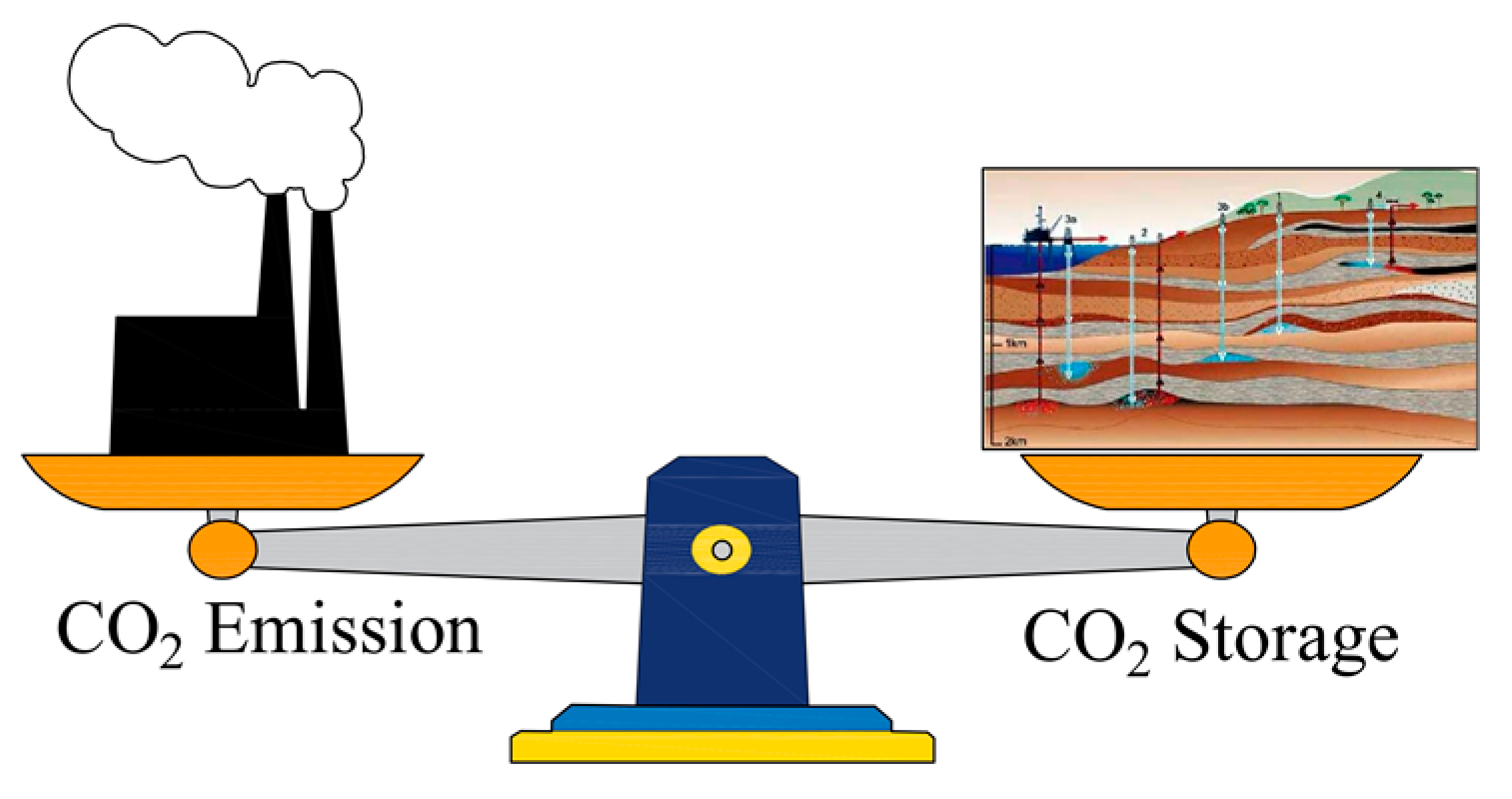
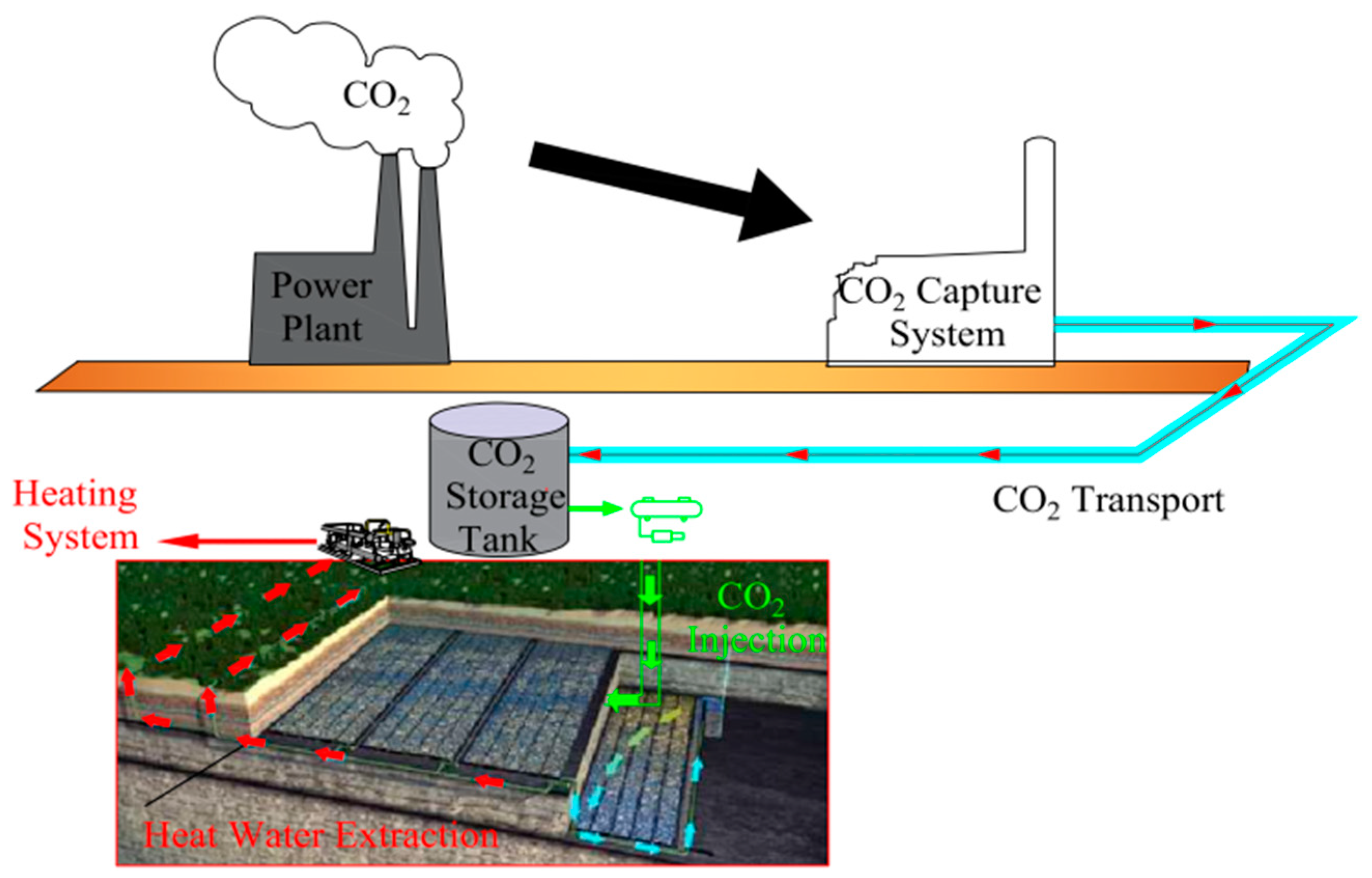

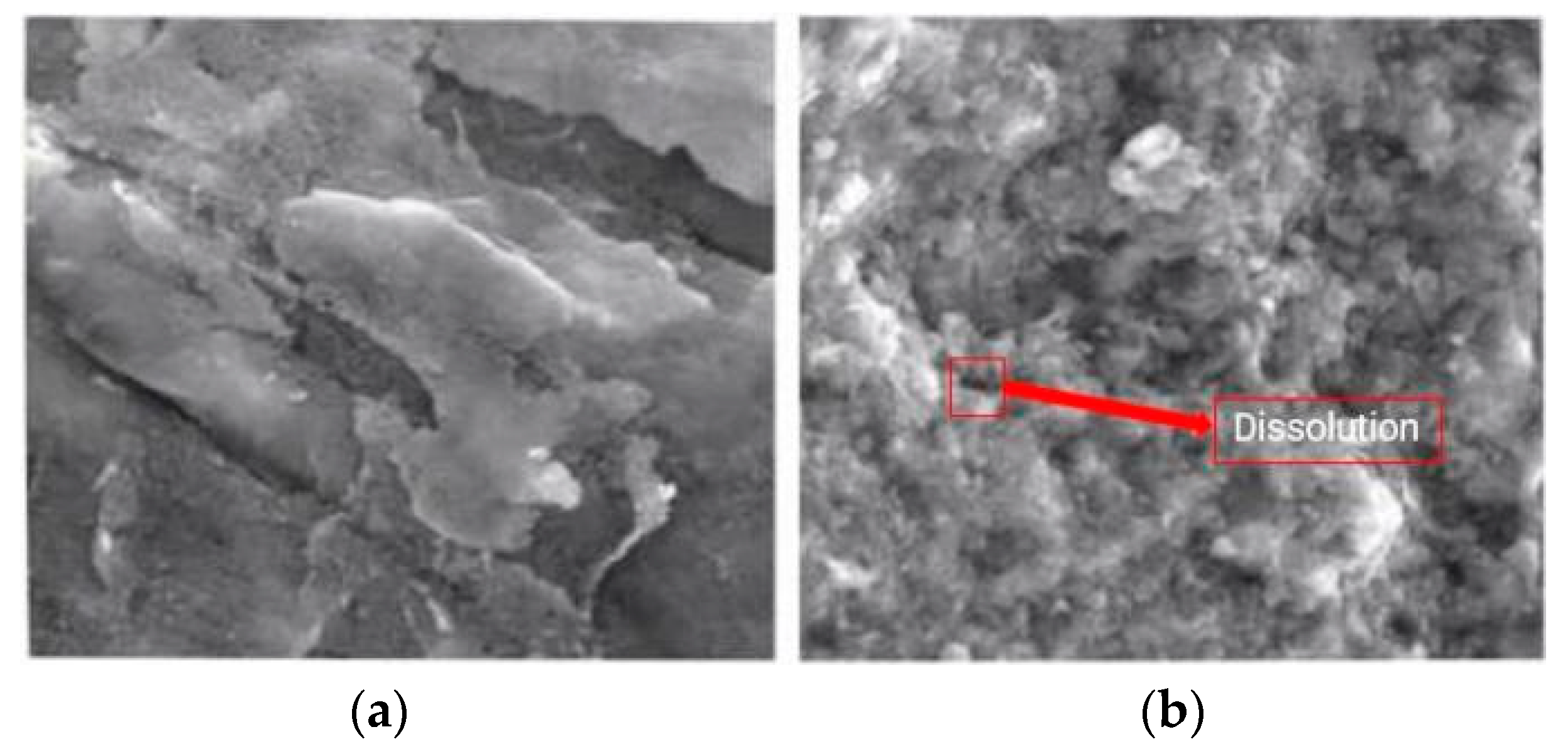
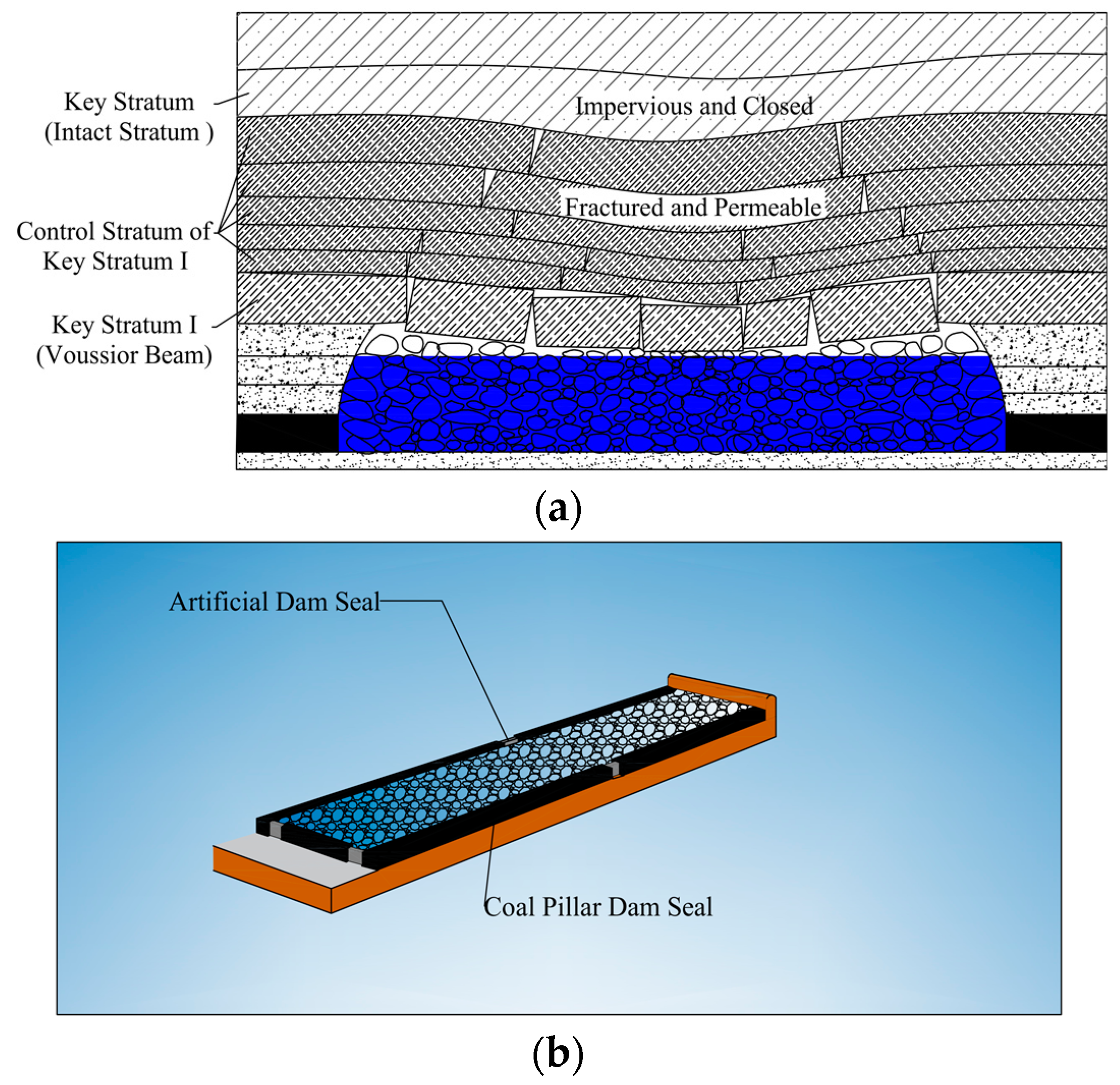
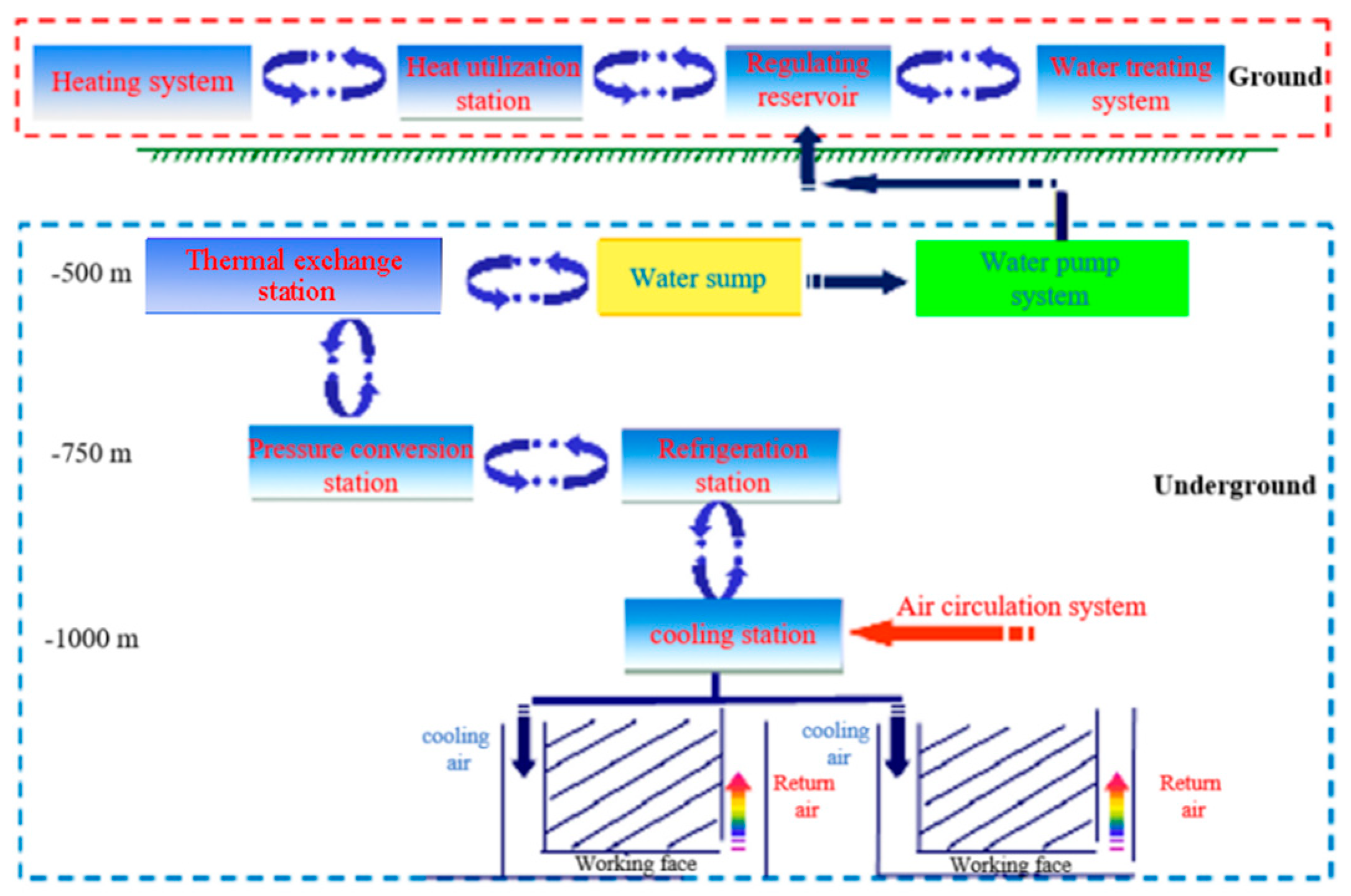
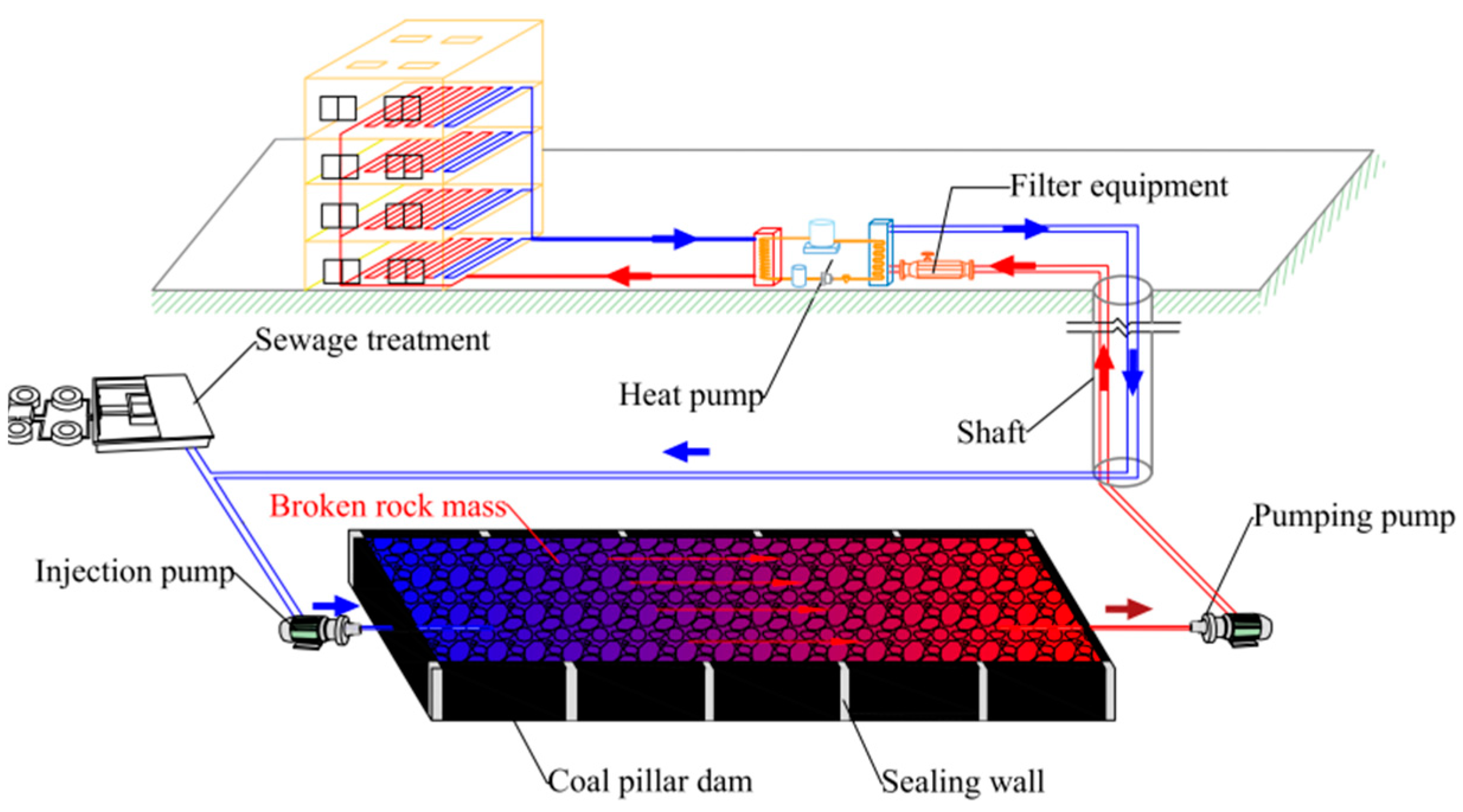

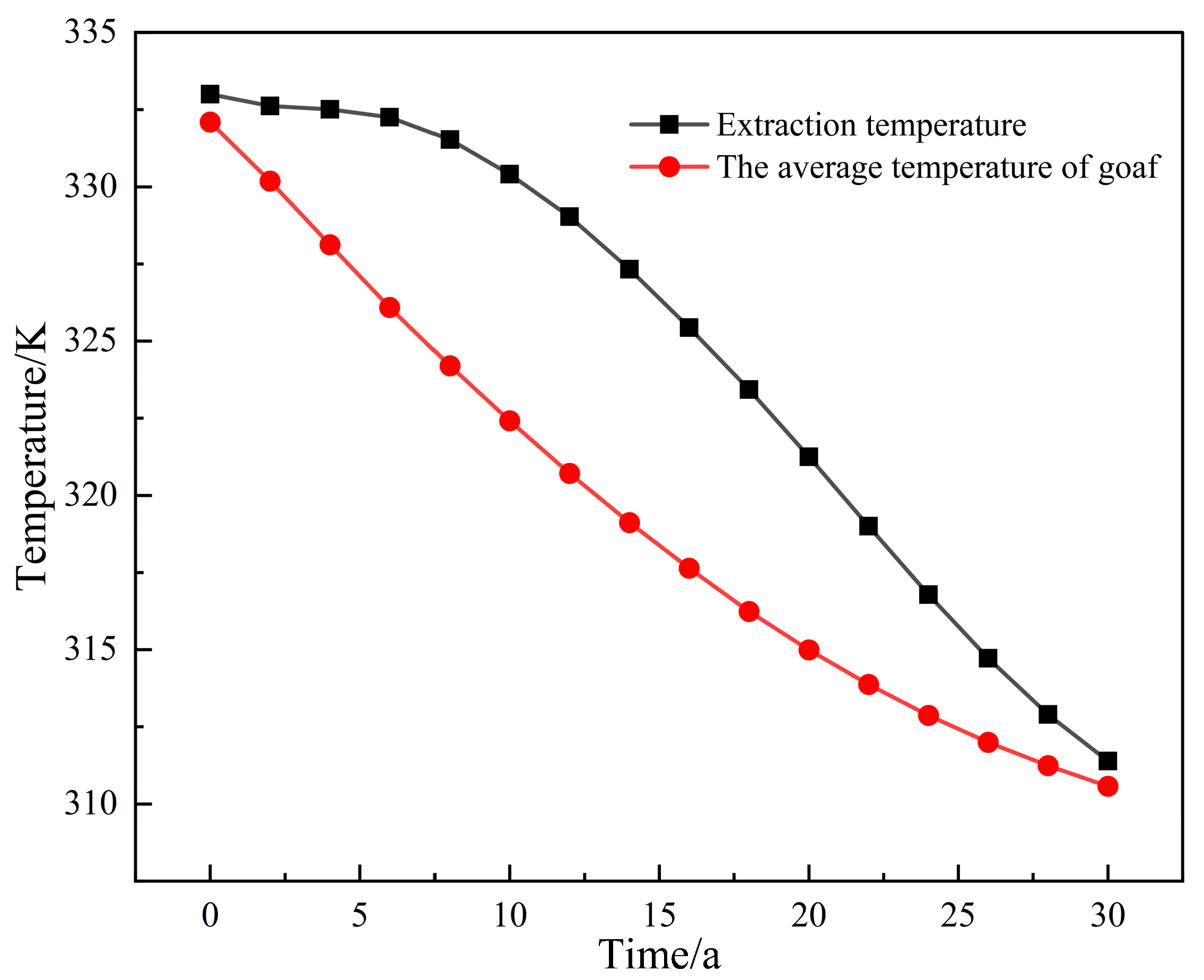
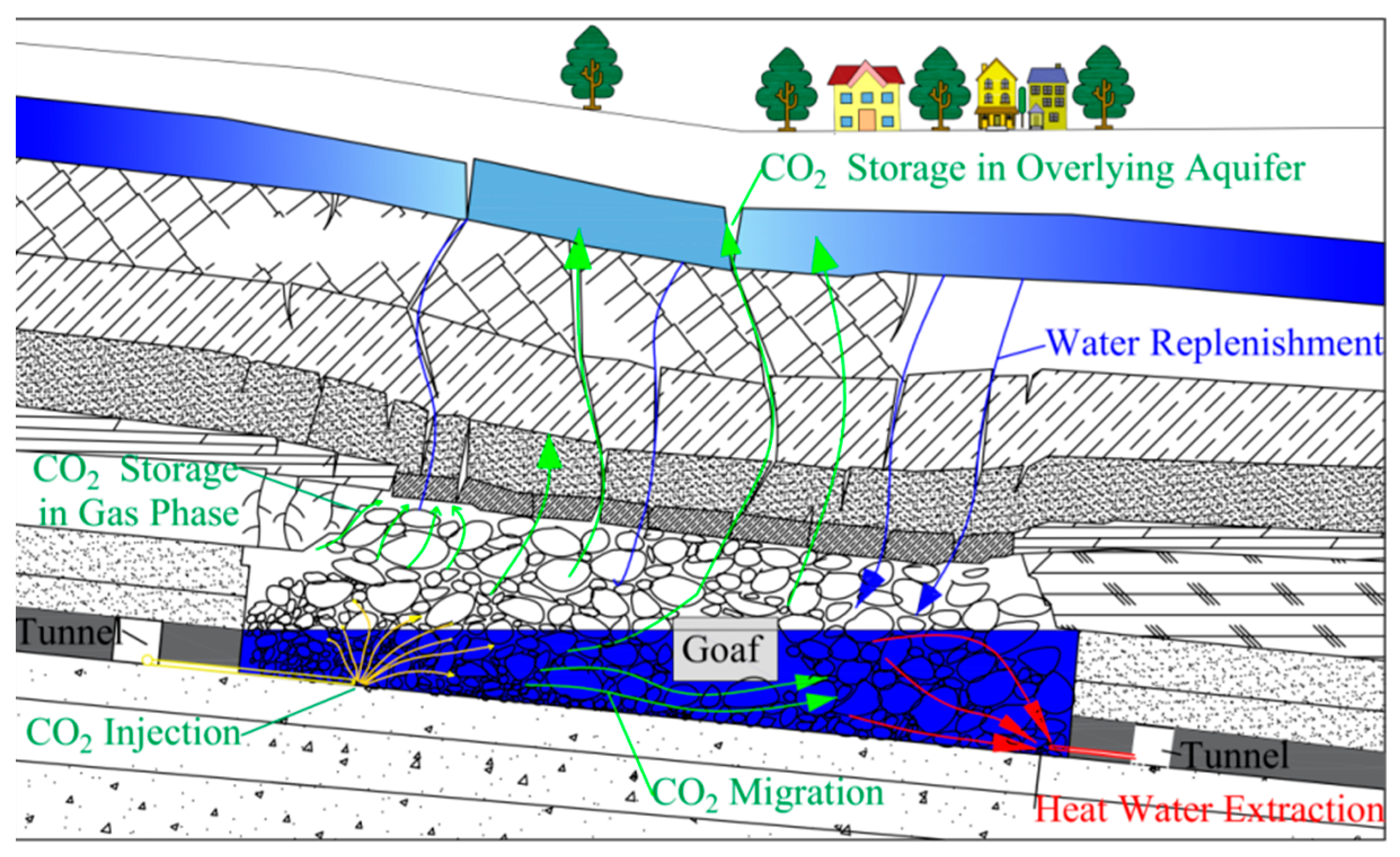

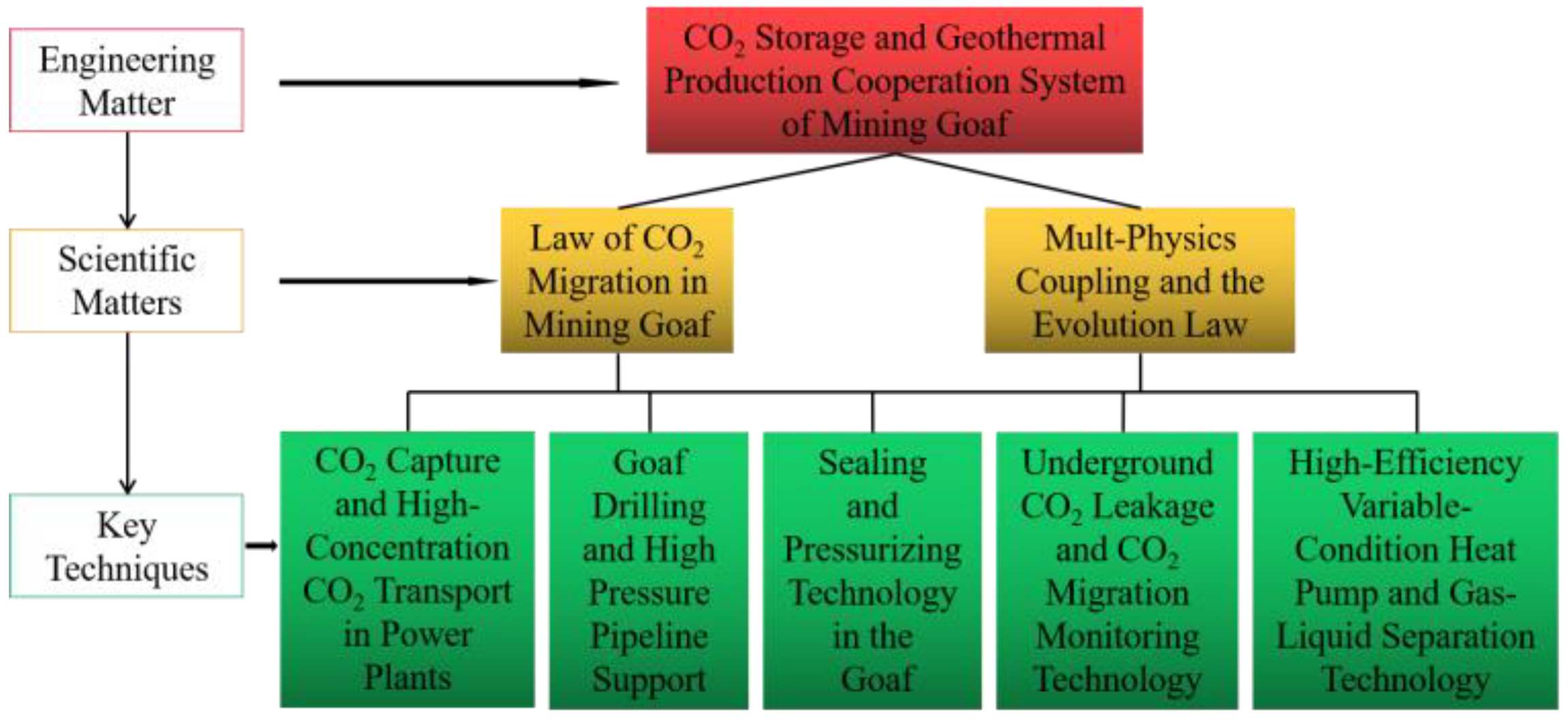
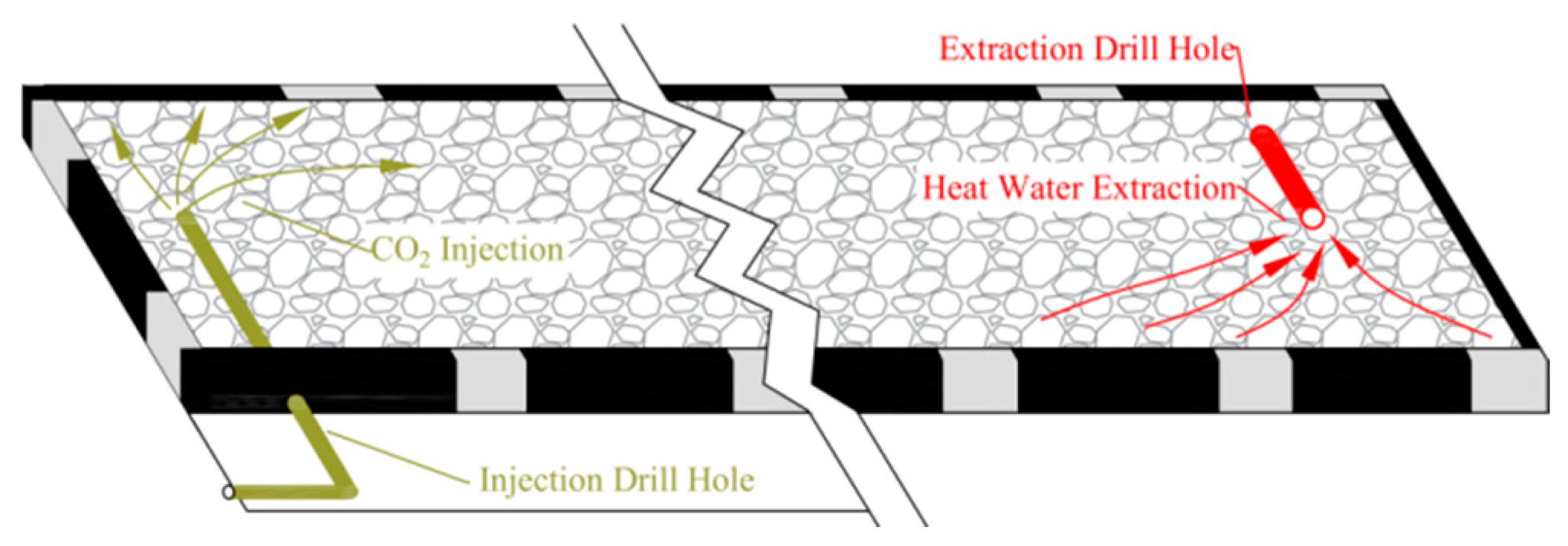
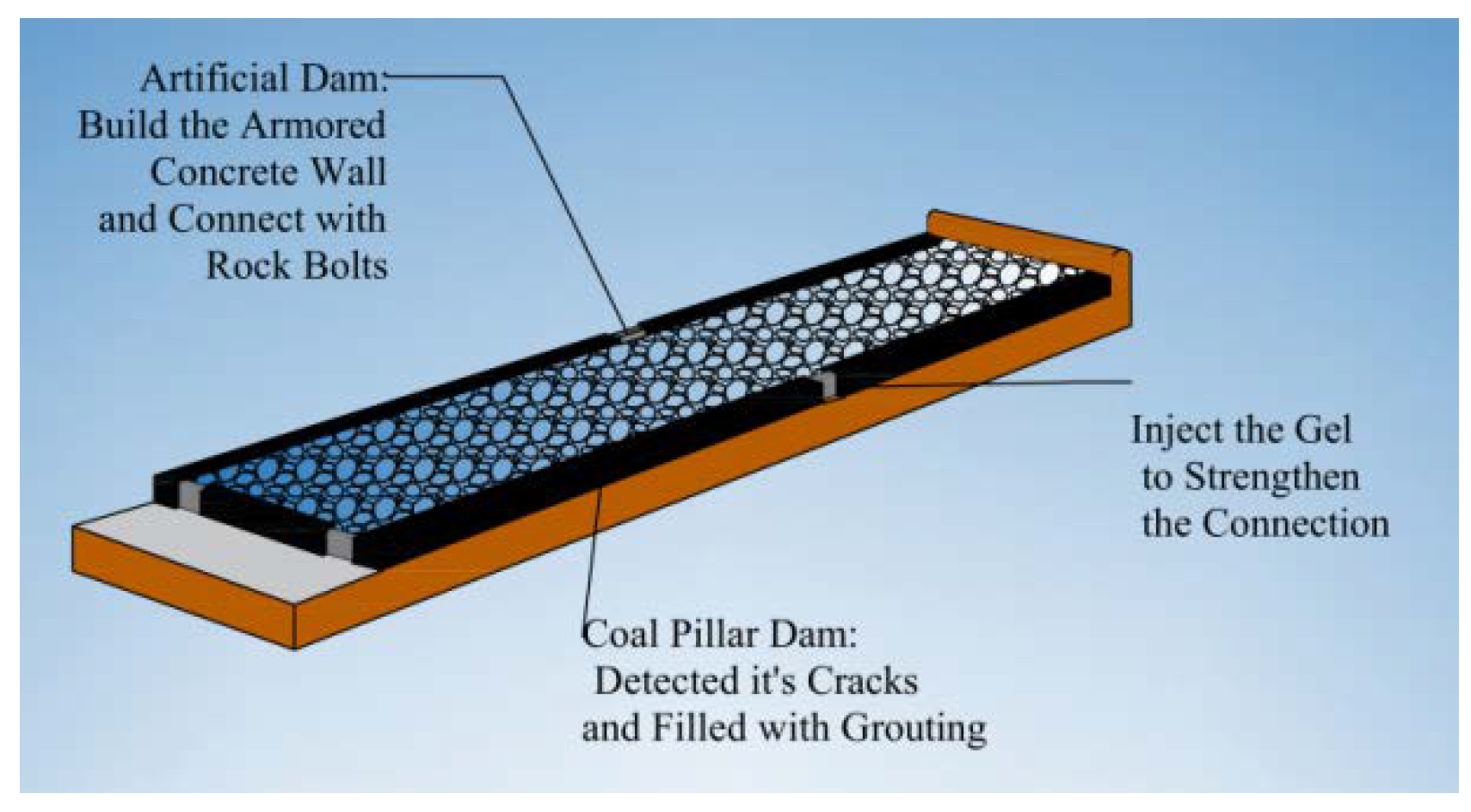
| Mineral | Element | Atomic Fraction before Reaction /% | Atomic Fraction after Reaction /% |
|---|---|---|---|
| Chlorite in coal | Mg | 0.95 | 0.89 |
| Al | 9.88 | 9.2 | |
| Si | 14.15 | 10.84 | |
| Kaolinite in coal | Al | 15.87 | 12.63 |
| Si | 17.54 | 13.56 | |
| Illite in coal | Al | 11.87 | 4.56 |
| Si | 17.19 | 13.96 | |
| Kaolinite in sandy mudstone | Al | 14.04 | 9.04 |
| Si | 15.71 | 9.95 | |
| Chlorite in sandy mudstone | Mg | 5.91 | 1.18 |
| Calcite in sandstone | Ca | 17.3 | 15.51 |
| Chemical Element | Proportion of Main Elements/% | |
|---|---|---|
| Before Reaction | After Reaction | |
| CO2 | ||
| C | 0 | 8.53 |
| Si | 22.09 | 17.90 |
| Al | 27.43 | 22.84 |
| O | 48.76 | 50.49 |
| Chemical Element | Proportion of Main Elements/% | |
|---|---|---|
| Before Reaction | After Reaction | |
| CO2 | ||
| C | 11.2 | 11.35 |
| O | 42.46 | 42.1 |
| Ca | 46.35 | 46.56 |
Publisher’s Note: MDPI stays neutral with regard to jurisdictional claims in published maps and institutional affiliations. |
© 2022 by the authors. Licensee MDPI, Basel, Switzerland. This article is an open access article distributed under the terms and conditions of the Creative Commons Attribution (CC BY) license (https://creativecommons.org/licenses/by/4.0/).
Share and Cite
Wang, F.; Yan, J. CO2 Storage and Geothermal Extraction Technology for Deep Coal Mine. Sustainability 2022, 14, 12322. https://doi.org/10.3390/su141912322
Wang F, Yan J. CO2 Storage and Geothermal Extraction Technology for Deep Coal Mine. Sustainability. 2022; 14(19):12322. https://doi.org/10.3390/su141912322
Chicago/Turabian StyleWang, Fangtian, and Jinghong Yan. 2022. "CO2 Storage and Geothermal Extraction Technology for Deep Coal Mine" Sustainability 14, no. 19: 12322. https://doi.org/10.3390/su141912322
APA StyleWang, F., & Yan, J. (2022). CO2 Storage and Geothermal Extraction Technology for Deep Coal Mine. Sustainability, 14(19), 12322. https://doi.org/10.3390/su141912322







